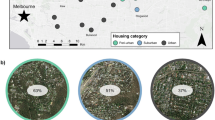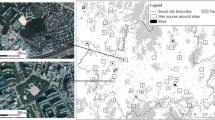Abstract
Urbanization reduces the quantity of native vegetation and alters its local structure and regional spatial pattern. These changes cause local extirpations of bird species associated with native vegetation and increases in the abundance and number of bird species associated with human activity. We used 54–1 km2 landscapes in the Seattle, Washington, USA metropolitan area to determine (1) the relative importance of habitat quantity, structure, and pattern to bird diversity and abundance and (2) whether housing developments can be managed to mitigate the negative impacts of urbanization on forest bird diversity. In general, bird species richness was high and many native forest species were retained where urban landcover comprised less than 52% of the landscape, tree density (especially that of evergreens) remained at least 9.8 trees/ha in developments, and forest was at least 64% aggregated across the landscape. These results suggest that the quantity, structure, and pattern of forested habitat affected breeding bird diversity in urbanizing landscapes. However, habitat pattern appeared less influential than other habitat attributes when results from all community- and population-level analyses were considered. Conservation of native birds in reserves can be supplemented by managing the amount, composition, structural complexity, and—to a lesser extent—arrangement of vegetation in neighborhoods.
Similar content being viewed by others
References
Alberti M, Botsford E, Cohen A (2001) Quantifying the urban gradient: linking urban planning and ecology. In: Marzluff JM, Bowman R, Donnelly R (eds) Avian Ecology and Conservation in an Urbanizing World, Kluwer Academic Publishers, Norwell, pp. 89–116
Alberti M, Marzluff JM (2004) Ecological resilience in urban ecosystems: linking urban patterns to human and ecological functions. Urban Ecosyst 7:241–265
Andren H (1994) Effects of habitat fragmentation on birds and mammals in landscapes with different proportions of suitable habitat: a review. Oikos 71:355–366
Atmar W, Patterson BD (1993) The measure of order and disorder in the distribution of species in fragmented habitat. Oecologia 96:373–382
Baker WL [online] (1997) The r.le Programs. Version 2.2. http://www.baylor.edu/~grass/gdp/terrain/rle22.html (6 June 1997)
Beissinger SR, Osborne DR (1982) Effects of urbanization on avian community organization. Condor 84:75–83
Berry BJL (1990) Urbanization. In: Turner BL, Clark WC, Kates RW, Richards JF (eds) Earth as Transformed by Human Action, Cambridge University Press, New York, pp. 103–119
Blair RB (1996) Land use and avian species diversity along an urban gradient. Ecological Appl 6:506–519
Blewett CM, Marzluff JM (2005) Effects of urban sprawl on snags and the abundance and productivity of cavity-nesting birds. Condor 107:677–692
Booth DE (1991) Estimating prelogging old-growth in the Pacific Northwest. J Forestry 89:25–29
Botsford ER (2000) Development of a Modified Land Composition Classification Methodology Utilizing LANDSAT Thematic Mapping and Ancillary Data. M.S. thesis, University of Washington, Seattle
Brown JH, Kodric-Brown A (1977) Turnover rates in insular biogeography: effect of immigration on extinction. Ecol 58:445–449
Bunnell FL (1999) What habitat is an island? In: Rochelle JA, Lehmann LA, Wisniewski J (eds) Forest Fragmentation: Wildlife and Management Implications, Brill, Boston, pp. 1–31
Burnham KP, Anderson DR (1998) Model Selection and Inference: a Practical Information-theoretic Approach, 1st edn. Springer-Verlag, New York, NY
Chace JF, Walsh JJ (2006) Urban effects on native avifauna: a review. Landscape and Urban Planning 74:46–69
Cooper CB, Walters JR (2002) Experimental evidence of disrupted dispersal causing decline of an Australian passerine in fragmented habitat. Conserv Biol 16:471–478
Donnelly R (2002) Design of Habitat Reserves and Settlements for Bird Conservation in the Seattle Metropolitan Area. Ph.D. dissertation, University of Washington, Seattle
Donnelly R, Fleishman E (In review) Application of nestedness analysis to biodiversity conservation in urbanizing areas. Landscape and Urban Planning
Donnelly R, Marzluff JM (2004) Importance of reserve size and landscape context to urban bird conservation. Conserv Biol 18:733–745
Ewing RH (1994) Characteristics, causes, and effects of sprawl: a Literature review. Environ Urban Issues 305:1–15
Fahrig L (1997) Relative effects of habitat loss and fragmentation on population extinction. J Wildl Manage 61:603–610
Fahrig L (1998) When does fragmentation of breeding habitat affect population survival. Ecological Modelling 105:273–292
Franklin JF, Dyrness CT (1988) Natural vegetation of Oregon and Washington. Oregon State University Press,Corvallis
Garrison GA (1949) Uses and modifications for the “Moosehorn” crown closure estimator. J Forestry 47:733–734
Germaine SS, Rosenstock SS, Schweinsburg RE, Richardson WS (1998) Relationships among breeding birds, habitat, and residential development in greater Tucson, Arizona. Ecological Applications 8:680–691
Gotelli NJ, Entsminger GL [online] (2002) EcoSim: Null Models Software for Ecology. Version 7.0. http://homepages.together.net/~gentsmin/ecosim.htm (9 September 2002)
Haila Y (2002) A conceptual genealogy of fragmentation research: from island biogeography to landscape ecology. Ecolo Appl 12:321–334
Harrison S, Bruna E (1999) Habitat fragmentation and large-scale conservation: what do we know for sure? Ecography 22:225–232
Johnston RF (2001) Synanthropic birds of north America. In: Marzluff JM, Bowman R, Donnelly R (eds) Avian Ecology and Conservation in an Urbanizing World, Kluwer Academic Publishers, Norwell, pp. 49–68
Knight RL (1990) Ecological principles applicable to the management of urban ecosystems. In: Webb EA, Foster SQ (eds) Perspectives in Urban Ecology, Denver Museum of Natural History and Thorne Ecological Institute, Denver, pp. 24–34
Lancaster RK, Rees WE (1979) Bird communities and the structure of urban habitats. Canadian Journal of Zool 57:2358–2368
Lichstein JW, Simons TR, Franzreb KE (2002) Landscape effects on breeding songbird abundance in managed forests. Ecol Appl 12:836–857
Lomolino ML (1996) Investigating causality of nestedness of insular communities: selective immigrations or extinctions. J Biogeogr 23:699–703
Magurran AE (1988) Ecological Diversity and Its Measurement. Princeton University Press, Princeton
Major RE, Gowing G, Kendal CE (1996) Nest predation in Australian urban environments and the role of the Pied Currawong, Strepera graculinaation, in Australia. Australian J Ecol 21:399–409
Marzluff JM (2001) Worldwide urbanization and its effects on birds. In: Marzluff JM, Bowman R, Donnelly R (eds) Avian Ecology and Conservation in an Urbanizing World, Kluwer Academic Publishers, Norwell, pp. 19–48
Marzluff JM (2005) Island biogeography for an urbanizing world: how extinction and colonization may determine biological diversity in human-dominated landscapes. Urban Ecosyst 8:157–177
Marzluff JM, Bowman R, Donnelly R (2001a) An historical perspective on urban bird research: trends terms, and approaches. In: Marzluff JM, Bowman R, Donnelly R (eds) Avian Ecology and Conservation in an Urbanizing World, Kluwer Academic Publishers, Norwell, pp. 1–18
Marzluff JM, Bowman R, Donnelly R (eds) (2001b) Avian Ecology and Conservation in an Urbanizing World. Kluwer Academic Publishers, Norwell
Marzluff JM, McGowan KJ, Donnelly R, Knight RL (2001c) Causes and consequences of expanding American crow populations. In: Marzluff JM, Bowman R, Donnelly R, (eds) Avian Ecology and Conservation in an Urbanizing World, Kluwer Academic Publishers, Norwell, pp. 331–364
Marzluff JM, Ewing K (2001) Restoration of fragmented landscapes for the conservation of birds: a general framework and specific recommendations for urbanizing landscapes. Restoration Ecol 9:280–292
McGarigal K, Cushman SA, Neel MC, Ene E [online] (2002) Spatial Pattern Analysis Program for Categorical Maps, FRAGSTATS 3.1. http://www.umass.edu/landeco/research/fragstats/fragstats.html (5 May-2002)
McKinney ML (2002) Urbanization biodiversity, and conservation. Biosci 52:883–890
Miller JR, Hobbs RJ (2000) Conservation where people live and work. Conservation Biology 16:330–337
Munyenyembe F, Harris J, Hone J (1989) Determinants of bird populations in an urban area. Australian J Ecol 14:549–557
Nuorteva P (1971) The synanthropy of birds as an expression of the ecological cycle disorder caused by urbanization. Annales Zoologici Fennici 8:547–553
Oliver CD, Larson BC (1996) Forest Stand Dynamics. John Wiley and Sons, New York
Opdam P, van Dorp D, ter Braak CJF (1984) The effect of isolation on the number of woodland birds in small woods in the Netherlands. J Biogeogr 11:473–478
Penland ST (1984) Avian Responses to a Gradient of Urbanization in Seattle, Washington. Ph.D. dissertation, University of Washington, Seattle
Pitelka RA (1942) High population of breeding birds within an artificial habitat. Condor 44:172–174
Puget Sound Regional Council (1997) Urban Centers in the Central Puget Sound Region: A Baseline Summary and Comparison. Puget Sound Regional Council, Seattle
Pyle RM (1980) Management of nature reserves, In: Soulé ME, Wilcox BA (eds) Conservation Biology: an Evolutionary-ecological Perspective, Sinauer, Sunderland, pp. 319–327
Ralph CJ, Geupel GR, Pyle P, Martin TE, Desante DF (1993) Handbook of Field Methods for Monitoring Landbirds. U.S. Department of Agriculture, Forest Service, Pacific Southwest Research Station, Albany. General Technical Report PSW-GTR-144
Robinson L, Newell JP, Marzluff JM (2005) Twenty-five years of sprawl in the Seattle region: growth management responses and implications for conservation. Landscape and Urban Planning 71:51–72
Rosenstock S, Anderson D, Giesen K, Leukering T, Carter M (2002) Landbird counting techniques: current practices and an alternative. Auk 119:46–53
Shafer CL (1997) Terrestrial nature reserve design at the urban/rural interface. In: Schwartz MW (ed) Conservation in Highly Fragmented Landscapes, Chapman and Hall, New York, pp. 345–378
Soulé ME (1991) Land use planning and wildlife maintenance: guidelines for conserving wildlife in urban landscapes. Journal of the American Planning Association 57:313–323
Soulé ME, Bolger DT, Alberts AC, Wright J, Sorice M, Hill S (1988) Reconstructed dynamics of rapid extinctions of chaparral-requiring birds in urban habitat islands. Conservation Biology 2:75–92
Statistical Package for Social Sciences (2001) SPSS 10.1.3. SPSS, Chicago
Thomas JA, Bourn NAD, Clarke RT, Stewart KE, Simcox DJ, Pearman GS, Curtis R, Goodger B (2001) The quality and isolation of habitat patches both determine where butterflies persist in fragmented landscapes. Proce Royal Soc of Lond B268:1791–1796
United Nations (1999) The State of the World Population 1999 – 6 Billion, a time for choices. United Nations, New York
Vitousek PM, Mooney HA, Lubchenco J, Melillo JM (1997) Human domination of Earth’s ecosystems. Sci 277:494–509
Wang Y, Moskovits DK (2001) Tracking fragmentation of natural communities and changes in land cover: applications of LANDSAT data for conservation in an urban landscape. Conserv Biol 15:835–843
Whitcomb RF, Robins CS, Lynch JF, Whitcomb BL, Klimkiewicz MK, Bystrak D (1981) Effects of forest fragmentation on avifauna of the eastern deciduous forest. In: Burgeos R, Sharpe D (eds) Forest Stand Dynamics in Man-dominated Landscapes, Springer-Verlag, New York, pp. 125–205
Wilcove DS (1985) Nest predation in forest tracts and the decline of migratory songbirds. Ecol 66:1211–1214
Author information
Authors and Affiliations
Corresponding author
Rights and permissions
About this article
Cite this article
Donnelly, R., Marzluff, J.M. Relative importance of habitat quantity, structure, and spatial pattern to birds in urbanizing environments. Urban Ecosyst 9, 99–117 (2006). https://doi.org/10.1007/s11252-006-7904-2
Published:
Issue Date:
DOI: https://doi.org/10.1007/s11252-006-7904-2




